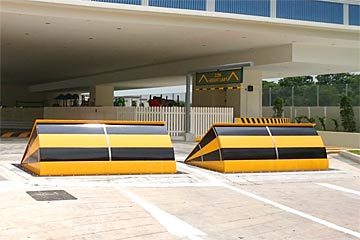Things about Wedge Barriers
Wiki Article
What Does Wedge Barriers Mean?
Table of ContentsA Biased View of Wedge BarriersWedge Barriers - An Overview

Wedge Barriers for Dummies
The staying pressure used to the cam web cam deploy release wedge plate 16 may be provided supplied an electromechanical actuator 84 or other various other. The springtime setting up 54 and the actuator 84(e. Wedge Barriers. g., electromechanical actuator)might run together to translate the webcam and lift the wedge plate 16.
As stated over, the springtime setting up 54 exerts a constant force on the cam, while the electromechanical actuator might be regulated to exert a variable force on the webcam, consequently making it possible for the lifting and lowering( i. e., deploying and retracting )of the wedge plate 16. In certain embodiments, the consistent pressure used by the springtime assembly 54 may be adjustable. g., electromechanical actuator) is handicapped. As will be appreciated, the spring assembly 54 might be covered and shielded from particles or various other components by a cover plate(e. g., cover plate 68 revealed in FIG. 4) that might be substantially flush with the raised surface area 38 of the structure 14. As stated over, in the deployed position, the wedge plate 16 serves to block accessibility or traveling past the obstacle 10. The obstacle 10(e. g., the wedge plate 16 )may block pedestrians or vehicles from accessing a residential or commercial property or path. As talked about above, the barrier 10 is affixed to the support 30 secured within the structure 14,

front braces 71. Consequently, the linkage assemblies 72 may pivot and rotate to enable the collapse and expansion of the linkage assemblies 72 during retraction and deployment of the bather 10. The link assemblies 72 cause movement of the wedge plate 16 to be limited. If an automobile is taking a trip in the direction of the released wedge plate 16(e. For example, in one scenario, the safety legs 86 might be extended throughoutmaintenance of the barrier 10. When the safety legs 86 are deployed, the safety legs 86 sustain the weight of the wedge plate 16 against the surface area 12. Consequently, the lifting mechanism 50 might be shut down, serviced, eliminated, replaced, etc. FIG. 5 is partial viewpoint view of an embodiment of the surface-mounted wedge-style obstacle 10, highlighting the camera 80 and the camera surfaces 82 of the lifting device 50. Particularly, two cam surface areas 82, which are referred to as reduced web cam surfaces 83, are positioned below the web cam 80. The lower cam surface areas 83 try this web-site may be repaired to the surface area 12 (e. For instance, the lower cam surface areas 83 and the mounting plate 85 might develop a single item that is protected to the anchor 30 by screws or other mechanical fasteners. In addition, two web cam surface areas 82, which are referred to as upper cam surface areas 87, are placed above the camera 80 and paired to (e. In various other embodiments, intervening layers or plates may be placed in between the surface area 12 and the lower cam surface areas 83 and/or the wedge plate 16 and the top cam surfaces 87 As stated above, the web cam 80 translates along the web cam surfaces 82 when the wedge plate 16 is raised from the retracted setting to the deployed placement. Additionally, as stated above, the spring setting up 54 (see FIG. 3 )might offer a pressure acting upon the webcam 80 in the visit this site right here instructions 102 using spring rod 58, which might reduce the force the electromechanical actuator 84 is needed to relate to the cam 80 in order to check my source activate and raise the wedge plate 16. 1 )to the deployed position(see FIG. 4). As revealed, the web cam 80 includes track wheels 104(e. g., rollers), which get in touch with and convert along the cam surfaces 82 during procedure.
Report this wiki page